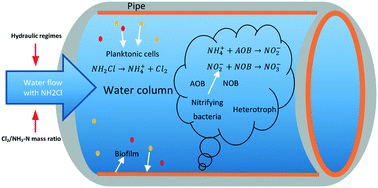Influence of hydraulic regimes and Cl2/NH3-N mass ratios on the bacterial structure and composition in an experimental flow cell chloraminated drinking water system†
Abstract
Chloramine is the secondary disinfectant used within drinking water distribution systems (DWDSs) for managing water quality. The growth of microorganisms is affected by operational conditions and the existence of these organisms in chloraminated systems can subsequently influence disinfection efficiency, particularly if the nitrification process happens. In the current study, a next generation sequencing (NGS) analysis using an Illumina MiSeq system was applied to investigate the influence of different hydraulic conditions and Cl2/NH3-N mass ratios on the bacterial structure and composition using an experimental temperature-controlled flow cell facility. The results obtained showed that the microbial community and structure were different between biofilm and water samples. Actinobacteria was the most dominant phylum within biofilms while Alphaproteobacteria was the most abundant in bulk water samples. There was no statistical difference in the microbial community in biofilms identified between different hydraulic regimes, suggesting that the biofilm is a stable matrix to the outer environment. Results further showed that the Cl2/NH3-N mass ratio had obvious effect on the microbial structure in biofilms. This suggests that excess ammonia is an influencing factor for microbial activity within biofilms. Within bulk water, species richness and diversity tended to be higher in lower hydraulic regimes. This confirms the influence of hydraulic conditions on the biofilm mechanical structure and further material mobilization to water. Opportunistic pathogens such as Legionella and Mycobacterium were detected in abundance in the experimental system. This confirms that nitrification can lead to the decrease of water quality and microbial outbreaks. This research provides ecological information regarding the influence of hydraulic regimes and Cl2/NH3-N mass ratios on the microbial structure and composition in experimental DWDSs experiencing the nitrification process.



 Please wait while we load your content...
Please wait while we load your content...